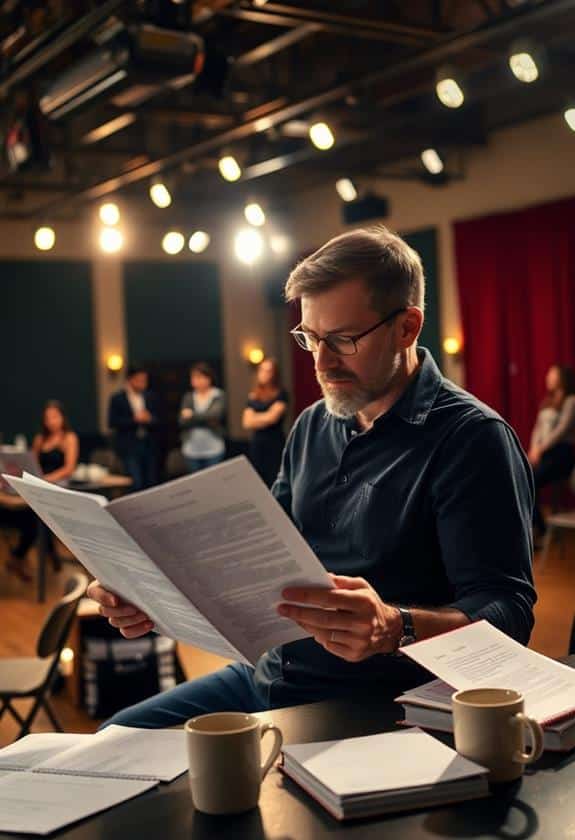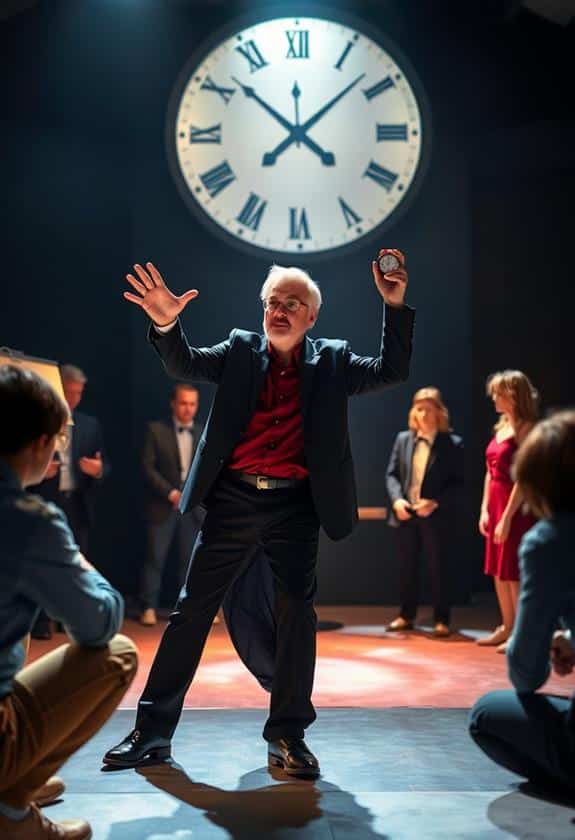To direct a scene well, start by really understanding your script—think of it as a treasure map! Communicate openly with your actors, creating a safe space where they can express their creativity. Planning your shots is essential; don’t forget a shot list to keep things organized! Timing is everything—allow pauses to build suspense or laughter. Finally, embrace flexibility. Sometimes things don’t go as planned, and that’s okay; adapt and improvise! I remember a scene where we had to ditch our entire plan because of rain, and it turned out to be magical. Stick around, and you’ll uncover even more directing tips!
Key Highlights
- Understand the script thoroughly to identify character motivations and emotional core, guiding the direction effectively.
- Create a collaborative environment with actors, encouraging open dialogue and providing positive feedback to enhance performances.
- Plan your shots meticulously with a shot list to ensure organization and clarity during filming.
- Focus on timing to enhance emotional impact, allowing pauses and experimenting with pacing during rehearsals.
- Embrace flexibility by adapting plans, improvising when necessary, and maintaining a positive attitude to boost team morale.
Understand Your Script

To effectively direct a scene, you need to fully understand your script. Think of your script as a treasure map; it guides you to where the gold lies. You might face challenges, like figuring out the character’s motivations or the underlying themes, but that’s where the magic happens. Dive deep into each line, and don’t just skim the surface. Get to know your characters like they’re your friends. What do they want? What are their fears? Additionally, consider how vital filmmaking equipment, like an Acrylic Clapboard, can help streamline your process by keeping you organized during shoots.
When I first started directing, I often overlooked the details. I remember missing a vital line that changed the entire scene’s mood. Trust me, it’s not fun to realize that during a rehearsal. So, read the script multiple times. Make notes, highlight parts that stand out, and even ask yourself questions.
Also, envision how you want the scene to feel. Is it tense? Joyful? Understanding that emotional core will help you create a safer environment for your actors, allowing them to explore their roles. Remember, knowing your script isn’t just about memorization; it’s about connecting with the story. So grab that script, and let’s unearth the treasures within!
Communicate With Actors

Effective communication with actors is essential for bringing your vision to life on screen. When you’re on set, creating a safe and open environment is key. Talk to your actors like they’re your teammates. Share your thoughts, but also listen to theirs. This collaboration can spark some amazing ideas! Consider how sound can enhance the scene, and think about investing in top microphones for filmmaking to capture every moment clearly.
I remember directing a scene where an actor seemed a bit unsure. Instead of just giving directions, I asked how they interpreted their character. That simple question opened up a dialogue, and we found a fantastic approach together.
Don’t forget to encourage your actors. Let them know when they’re nailing a scene. Positive feedback can boost their confidence, making them feel safe to take risks. If something doesn’t work, keep your tone light. A little humor can ease tension. Just remember, directing is about teamwork.
Also, be clear about your expectations. If you want a specific emotion, explain why it matters. This way, they know what you’re aiming for, and it helps them connect with the scene even more. Your communication shapes their performance and creates a stronger bond, making your film all the more powerful!
Plan Your Shots

Once you’ve established strong communication with your actors, it’s time to focus on planning your shots. This step is essential because the way you capture a scene can completely change its impact. Think about the emotions you want to convey and how the camera can help with that.
Consider using a shot list to stay organized. Here’s a simple table to help you visualize different shot types:
| Shot Type | Description |
|---|---|
| Close-Up | Focuses on a character’s face, capturing emotions. |
| Medium Shot | Shows the character from the waist up, giving context. |
| Wide Shot | Displays the setting and characters, creating a sense of space. |
| Over-the-Shoulder | Puts the viewer in the character’s perspective, enhancing connection. |
As you plan, remember to prioritize safety on set. Avoid crowded areas or tricky angles that could put anyone at risk. During my first shoot, we nearly tripped over cables! So, keep your workspace clear and communicate with your team. Great planning not only enhances your film but also keeps everyone safe and happy. After all, a safe set is a productive one!
Focus on Timing

Getting the timing right can make or break a scene. You may think it’s all about the action, but timing is essential for creating emotion and suspense. For instance, using tools like the Etekcity 5-in-1 Reflector can help manipulate light, enhancing the mood during pivotal moments. Imagine a dramatic moment when the character is about to confess their feelings. If you rush through it, the impact is lost. Take a breath, let the silence linger just a moment longer, and watch how it changes everything.
When you’re directing, pay attention to how your actors deliver their lines. Give them space to pause, allowing the audience to absorb the moment. I remember when I directed my first short film; I was so enthusiastic to keep things moving that I missed these golden opportunities. The result? A scene that fell flat.
Experiment with different pacing during rehearsals. Sometimes, slowing down can reveal nuances in the performance that you didn’t expect. And don’t forget about the rhythm of the dialogue. A well-timed joke can lighten the mood, while a sudden silence can heighten tension.
Embrace Flexibility

Flexibility is key in directing, allowing you to adapt to the unexpected moments that bring a scene to life. You might think you have everything planned out, but trust me, surprises will pop up. Embracing flexibility can transform those surprises into magical moments. When I directed my first short film, a sudden rain shower changed our outdoor shoot. Instead of panicking, I saw it as an opportunity to create a unique atmosphere, much like how the right affordable filmmaking gear can enhance unexpected creative choices.
Here are some tips to help you embrace flexibility:
- Stay open-minded: Be willing to adjust your vision based on what’s happening around you.
- Encourage collaboration: Your cast and crew might have great ideas that enhance the scene.
- Think on your feet: If something goes wrong, improvise! Sometimes, the best moments come from spontaneity.
- Trust your instincts: If a change feels right, go for it. Your gut often knows best.
- Maintain a positive attitude: Your energy influences the team, so keep it upbeat, even in challenging situations.
Frequently Asked Questions
What Equipment Should I Use for Directing a Scene?
When you’re directing a scene, you don’t need fancy gear to get started. A good camera—like a DSLR or even your smartphone—works wonders. Tripods help keep shots steady, and a microphone can capture clear audio. Lighting is essential, too; soft lamps or reflectors can brighten up your scenes. Don’t forget to use a notebook for jotting down ideas! It’s all about creativity; you’ll figure out what works best for you. Happy filming!
How Do I Choose the Right Location for Shooting?
Choosing the right location is like finding the perfect backdrop for your story’s heart. You want a place that reflects the mood and tone you’re aiming for. Think about safety first; well-lit, accessible spots are key. Consider how the location impacts your actors’ performances. I once shot in a cozy café, and the vibe brought warmth to our scene. So, scout around, trust your instincts, and let your vision shine!
What Should I Do if an Actor Misses Their Cue?
If an actor misses their cue, don’t panic! Just pause, take a breath, and calmly signal them to rejoin. Sometimes, a gentle reminder works wonders. You could say, “Hey, let’s pick up from here!” It’s all part of the process. Once, an actor forgot their line, and I quickly improvised a funny line to keep the energy up. Remember, staying relaxed keeps everyone comfortable and focused, making the scene even better!
How Can I Keep the Crew Motivated During Long Shoots?
To keep your crew motivated during those long shoots, try breaking up the day with fun activities or snacks. A quick game or a shared joke can lift spirits! Make sure everyone feels valued—acknowledge hard work and celebrate small wins. When you show genuine interest in their well-being, it fosters a positive atmosphere. Remember, it’s all about teamwork, so keep the energy high, and don’t forget to smile; it’s contagious!
What Are Effective Ways to Handle Unexpected Changes on Set?
Oh, unexpected changes on set? It’s like a surprise party where nobody’s invited! When things go off-script, stay calm and adapt. Communicate clearly with your crew; they’ll appreciate your transparency. Foster a solution-oriented mindset—brainstorm together! For instance, if an actor’s late, maybe shift scenes around. And don’t forget to laugh; a light-hearted moment can ease tension. Embrace the chaos; it’s all part of the filmmaking adventure!
Conclusion
So, there you have it! Directing a scene can feel like juggling flaming swords, but with practice, you’ll find your rhythm. Remember, every great filmmaker started somewhere, probably with a shaky camera and a wild idea. Trust your instincts, connect with your actors, and don’t be afraid to adapt when things go off-script. After all, the magic often happens in those unexpected moments. So, grab your script, gather your crew, and go create something amazing!




